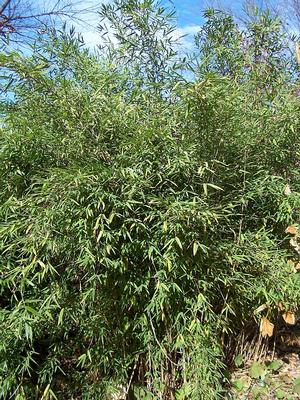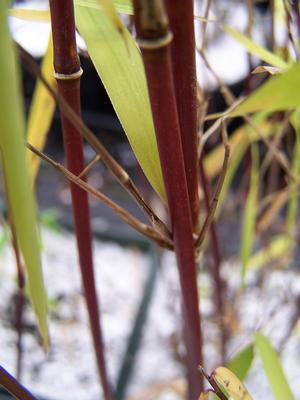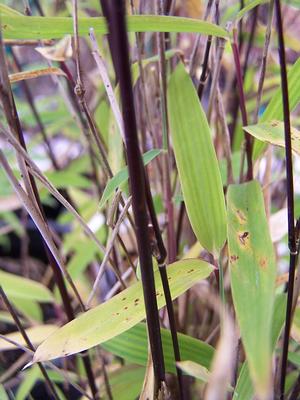
Fargesia nitida 'Juizhaigou'

The red stems of Fargesia nitida 'Juizhaigou'

and here are the black stems of Fargesia nitida 'Ravenwood'
Fargesia nitida: The Obedient Blue Fountain Bamboo
Do you pine for the unmatched elegance of bamboo but fear its notorious nature? It is true that many colonize rapidly with the sharp points of stems erupting from soil many feet away from the mother plant expanding with breathtaking alacrity. Stories abound of friendly neighbors now estranged because the family Golden Groove Bamboo trespassed onto the adjacent property and did not return home. (Why am I hearing the iconic theme music to the movie "Jaws" as the marauder encroaches?) I personally have met folks from the neighboring town of Hampton in peaceful Eastern Connecticut whose lovely man-made pond became a mud puddle of despair when greedy runners from a nearby Phyllostachys species punctured holes in the rubber liner. So much for the peaceful serenity of that Asian-inspired garden. However, well-behaved members of the family do exist. Though you may be skeptical it is a fact that Fargesia, one genus of true Bamboo, clumps - it does not run.
Fargesia is in the large and great Poaceae family, formerly known as Graminae. All Fargesia species expand in much the same manner as Giant Eulalia or Silver Maiden Grasses to which they are related. Crowns produce narrow hooks from which the culms ("culm" is the name given to a bamboo stem) rise pushing through the ground one growing season, maturing the next. These hook-shaped rhizomes are known as pachymorphs. This growth ritual ensures densely set culms on a slowly broadening plant, one that does not run. Unlike their larger more aggressive cousins Fargesia is not larger growing by comparison, at least in most instances. As with their rhizomes, culm size is smaller, too. Culm width may broaden to three-eighths inch which is typical but one half inch or so is not uncommon on an habituated, happy plant.
The Blue Fountain Bamboo found in high mountainous areas in China is adapted to cool temperatures. It is not suited to the deep south where it will likely languish in summer heat. Fargesia nitida is USDA hardy in zones 5 to cooler, shadier areas in 9. On the cold end of the spectrum it may possibly thrive into sheltered nooks of 4b (-25F). Some sites claim zone 3 hardiness. Though we are skeptical we do not know with certainty if zone 3 is possible. Can any one out there with hands-on knowledge share their experiences with us?
Fargesia are understory plants requiring shade, light to dappled is best. Though they will tolerate morning sun their leaves will curl in a self-protective effort if planted in hot afternoon exposures. Glaring afternoon sun for hours on end is an anathema even for those few species more tolerant of solar rays. Avoid locations too wet or too dry; constantly moist loam will keep them happy. Mature plants will tolerate some drought. Plants subjected to lengthy, punishing drought will suffer unless supplemented with life affirming replenishment.
The obedient bamboo graciously arches over in a respectful bow and can cascade to the ground as it approaches full size. Its glaucous culms often give it a bluish cast. The Blue Fountain Bamboos’ lance-shaped leaves are narrower than other species and tend to be matte finished. There is some genetic variation in this trait with some plants exhibiting a faint satin sheen. This gentle weeping attribute augments its gentle, elegant and soft affect.
Fargesia nitida is long-lived with most sources indicating about one hundred twenty years. Originally collected in the mountains of China circa 1886 they were in flower at that moment in time. Bamboos are monocarpic meaning they flower but once then die. As Fargesia is a crucial food for pandas when these flowering events occur and there is wholesale die-off beloved pandas suffer greatly. However, with life expectancy of one century plus twenty years give or take before flowering these magnificent grass relatives offer multiple decades of forage for pandas or when landscaped in the garden by our markers seeming perpetual elegance.
Fargesia nitida, perhaps the most planted species of this genus, is certainly the species which boasted the most named selections. It recently flowered world-wide. The event unfolded over 3 to 4 years at Quackin' Grass with not all selections flowering simultaneously. 'Anceps' and 'Ems River' were the first to bloom, 'McClure' soon thereafter with all the others followed. This granted us time to collect seed and begin a new generation of Blue Fountain Bamboo. We have many plants now. One of the great advantages to growing from seed is a spectrum of genetic expression. The search is on for distinct selections worthy of cultivar names.
We have already made one selection with the darkest purple culms we have ever found on this species. The culms of 'Ravenwood' are nearly as dark as the remarkable Phyllostachys nigra, the large running bamboo known as Black Bamboo. 'Ravenwood' culms are deep, dark red-purple to purple-black. They are darker and definitely blacker than those of the Red Fountain Bamboo, F. nitida 'Juizhaigou'. If 'Juizhaigou' is Red Fountain Bamboo then by logical extension (as logical as common monikers ever are) we posit 'Ravenwood' as the Black Fountain Bamboo.
It has been fascinating to observe the color range of culms. Most of our seed grown plants are green-stemmed but there are more shadowy purple individuals as well in various monochromatic hues. It is too soon to determine potential varying adult height. F. nitida generally grows between 10 and 15 feet. We hope for a handful of individuals with dwarf tendency. We would not be surprised if one or two plants exceed the doctrinaire height.
In the northeastern hills of Connecticut Fargesias remain green well into December turning a straw color come January. Spent leaves and culm sheaths tend to litter the ground around their base forming an attractive ecru natural mulch that tends to stay put. This feature depending upon ones aesthetic can be beautiful in fall and winter. And when capturing winter sun casts soft light and contrast to darker figures in the fairyland of the woodland realm. Mild spells during the coldest, shortest days of the calendar culms surprise us by unfurling some green leaves on branchlets as if by magic. In any season a plant's movement in breezes will transfix you. This dance is magical and mesmerizing.
When planting Fargesia I would suggest that one plant at the very least fully four feet from the walkway's perimeter or EPDM liner of a man-made pool. Remember that though they are not aggressive spreaders they do slowly gradually broaden girth with age. They could conceivably buckle a walkway or impact a pool liner in time. With that in mind, if space beyond the edge of a pool is not constricted a distance of greater than four feet may be wise as insurance that there will be no impact for a longer period of time but possibly not... better safe than sorry. As with interment of any plant common sense engaged and an understanding of growth habit must be considered.
If I have assuaged your skepticism then consider an obedient bamboo as a specimen. They may not offer the culm size of the larger growing species. On the other hand they are well-behaved and increasingly casually elegant. Place one near a water feature, at the edge of the woods or in the midst of a grove. Plant many in a jazzy, irregular row as a gorgeous screen or hedge. In any incarnation for a touch of refined grace plant Fargesia nitida. You’ll be glad you did.
penned by Wayne Paquette, March 21, 2015